An illustrated guide to the orchids of Australia
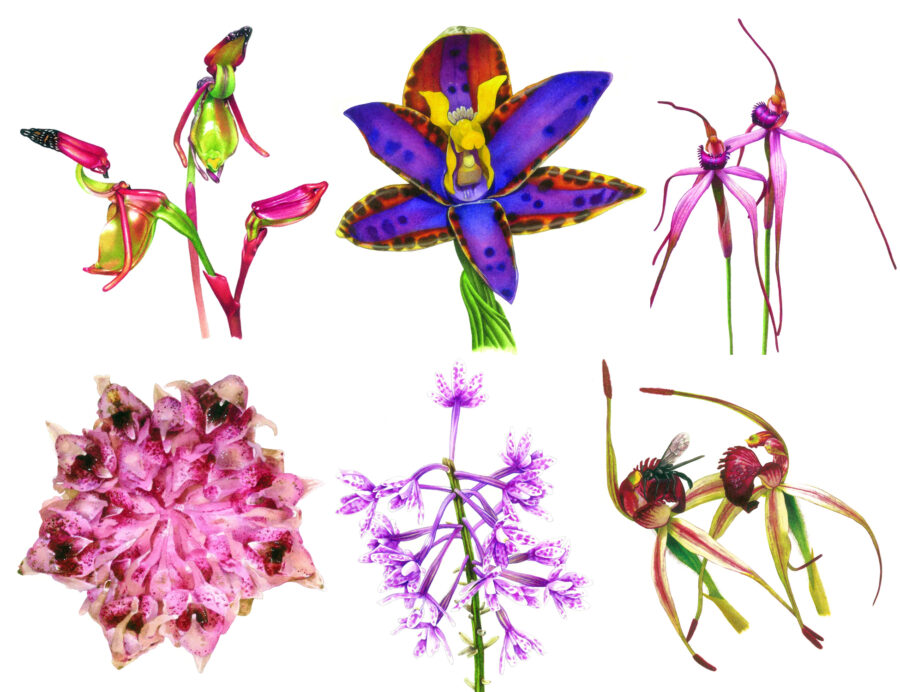
With more than 100 genera of orchids in Australia – the majority of which are ground-living and found nowhere else – it is impossible to cover the diversity without the weight of a large book.
We have more than 1700 of the 25–30,000 species in the Orchidaceae family known globally, yet, regrettably, 25 per cent of orchid extinctions occur here.
In part, our species are vulnerable because they require symbiotic relationships with specific types of ‘mycorrhizal’ fungi to grow and germinate, and many are pollinated by a unique species of pollinator.
Unravelling one thread in these complex relationships can have disastrous results.
Varieties that stand out are the greenhoods, flowering in winter and trapping unsuspecting fungal gnats to pollinate them. Spider orchids are the showy and alluring sirens, using several means to attract their pollinators. Sun orchids have numerous flowers resembling lilies and open on sunny days. Duck orchids employ entirely sexual deception to attract their pollinators. Perhaps the most bizarre of all are the underground orchids – members of a cryptic group that live out their lives entirely below the soil surface.
Which orchid is which?
The term mycorrhizal simply means “fungus root”. These microscopic fungi are found within individual plant cells from which the orchids absorb their nutrients; these can be located in the roots or other parts of the orchids. The degree of dependence on the fungus varies, with most orchids having the ability to draw energy from sunlight via chlorophyll. However, some orchids (such as hyacinth orchids and underground orchids) have taken this relationship to a point where they no longer have chlorophyll and derive all their nutrients from their fungal partner.
There are many ways in which Australian orchids are pollinated, but the majority require a third-party insect pollinator to transfer pollen from one plant to another. Some provide a pollen or nectar food reward; others simply mimic food-rewarding plants but provide no treat.
One of the more interesting pollination syndromes in Australia is sexual deception. Male thynnine wasps are drawn in by pheromones, and then copulate with the flowers, thinking they are female wasps. This transmits pollen between plants. These relationships are very specific, with many individual species of orchid pollinated by individual species of wasp.
Eastern underground orchid
Rhizanthella slateri
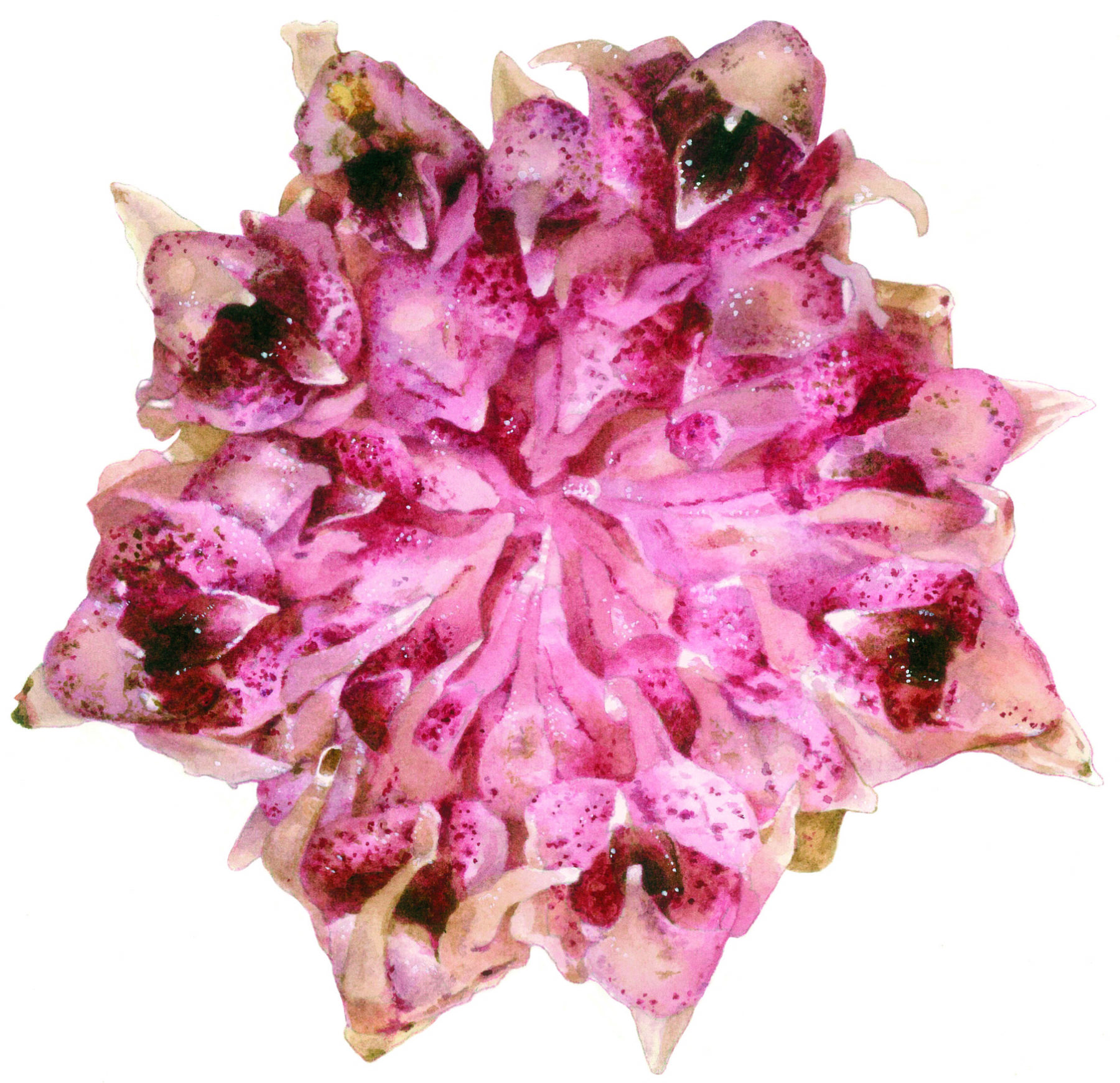
Confined to a few small patches in eastern Australia, bizarrely, this cryptic, endangered species completely lacks chlorophyll, relying on its fungal partner for nourishment. The seed of this genus is unusual among Australian orchids, as it is carried in a berry-like fruit, in contrast to the dust-like seed of others. The flowers are thought to be pollinated by fungal gnats and the seed is eaten and distributed by bandicoots.
Sunshine diuris
Diuris fragrantissima
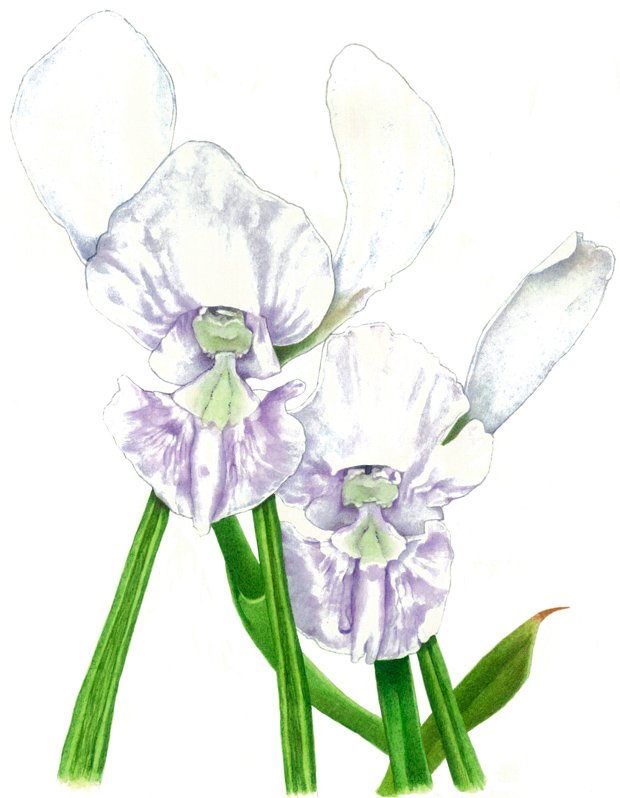
This stunning purple orchid was once widespread throughout the basalt grasslands of the Melbourne area, but now persists in the wild in only one original population encircled by houses, factories and railway lines. Conservation has been intensive and has led to reintroductions in other grasslands around Melbourne. It is thought to be pollinated by bees that are attracted to the lilies growing in the grasslands, and is germinated by Tulasnella fungi.
Stuart Mill spider orchid
Caladenia cretacea
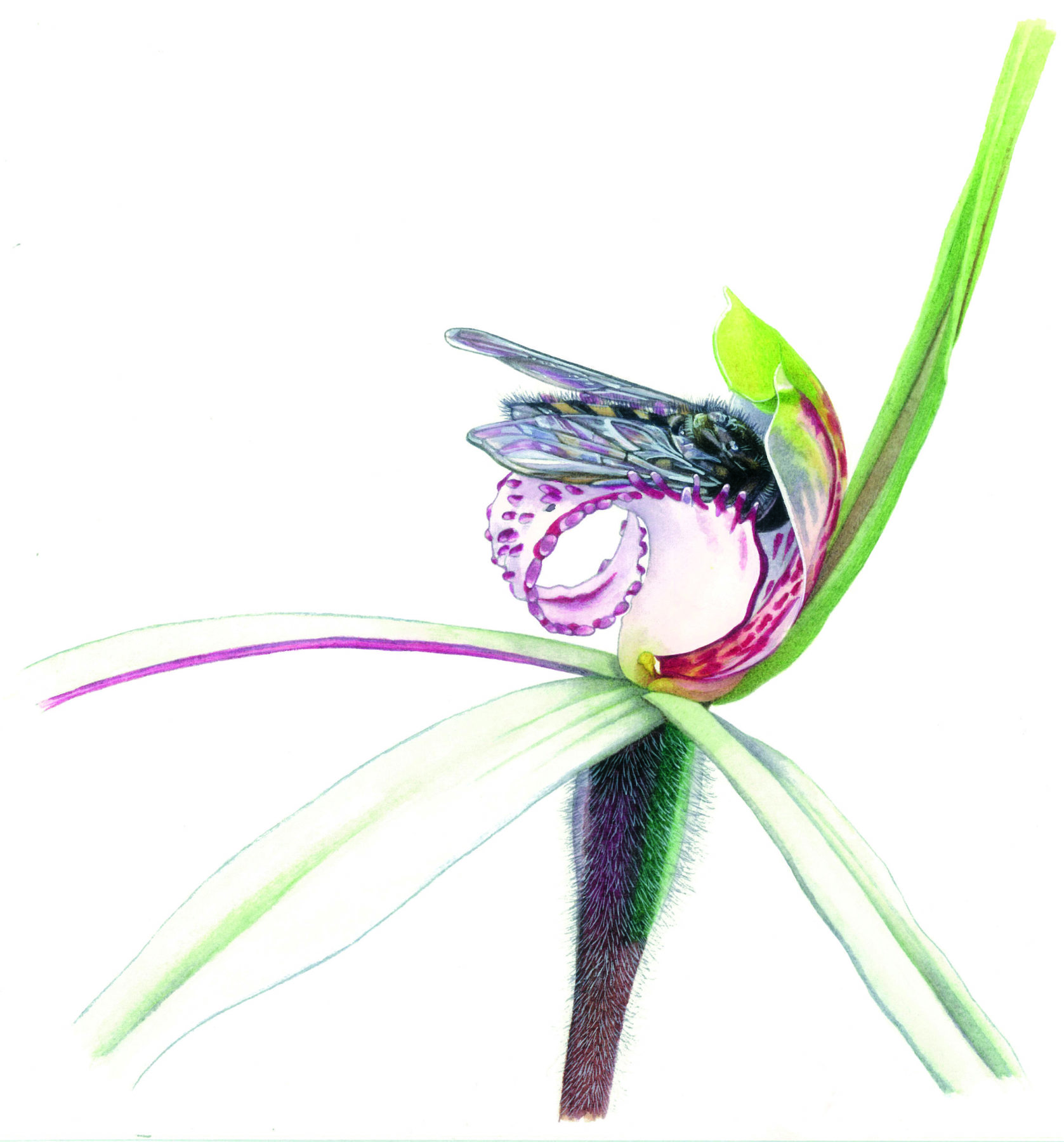
This endangered orchid is restricted to box ironbark forests in northern and western Victoria near Stuart Mill and is known from fewer than 1000 plants in eight populations. This orchid is thought to use food mimicry to attract native bee pollinators. Conservation efforts currently include propagation and habitat protection.
Bell flower hyacinth orchid
Dipodium campanulatum
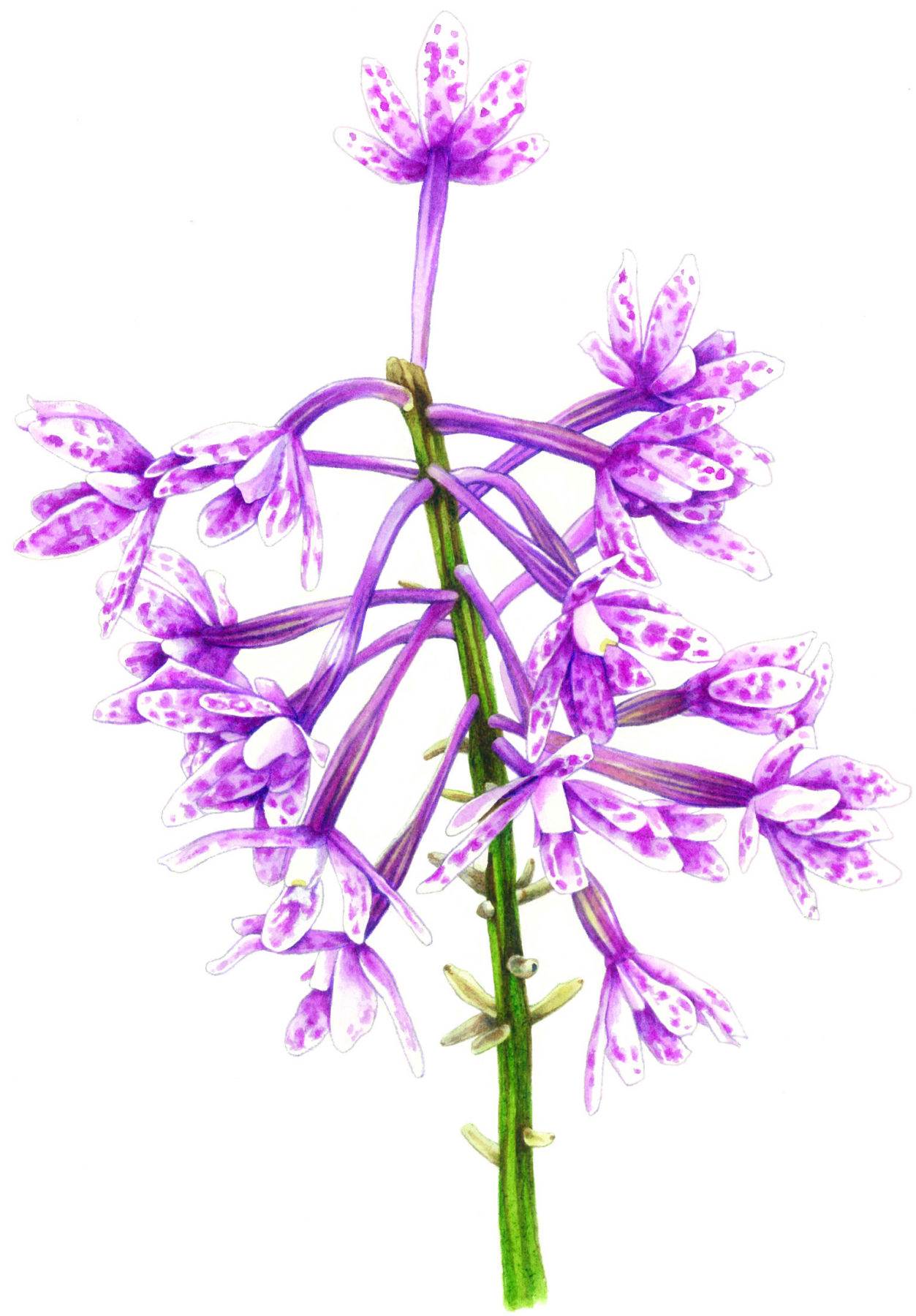
Known from fewer than 50 plants in Victoria, and a few hundred in SA, this species is in the process of being listed as nationally endangered. These plants lack chlorophyll or leaves, sending up a large flower spike during summer, which, after pollination (potentially by bees), produces many pods of tiny seeds. It’s thought that these orchids are completely reliant on their Russulaceae fungal partner, which also colonises the roots of eucalypts.
Desert greenhood
Pterostylis xerophila
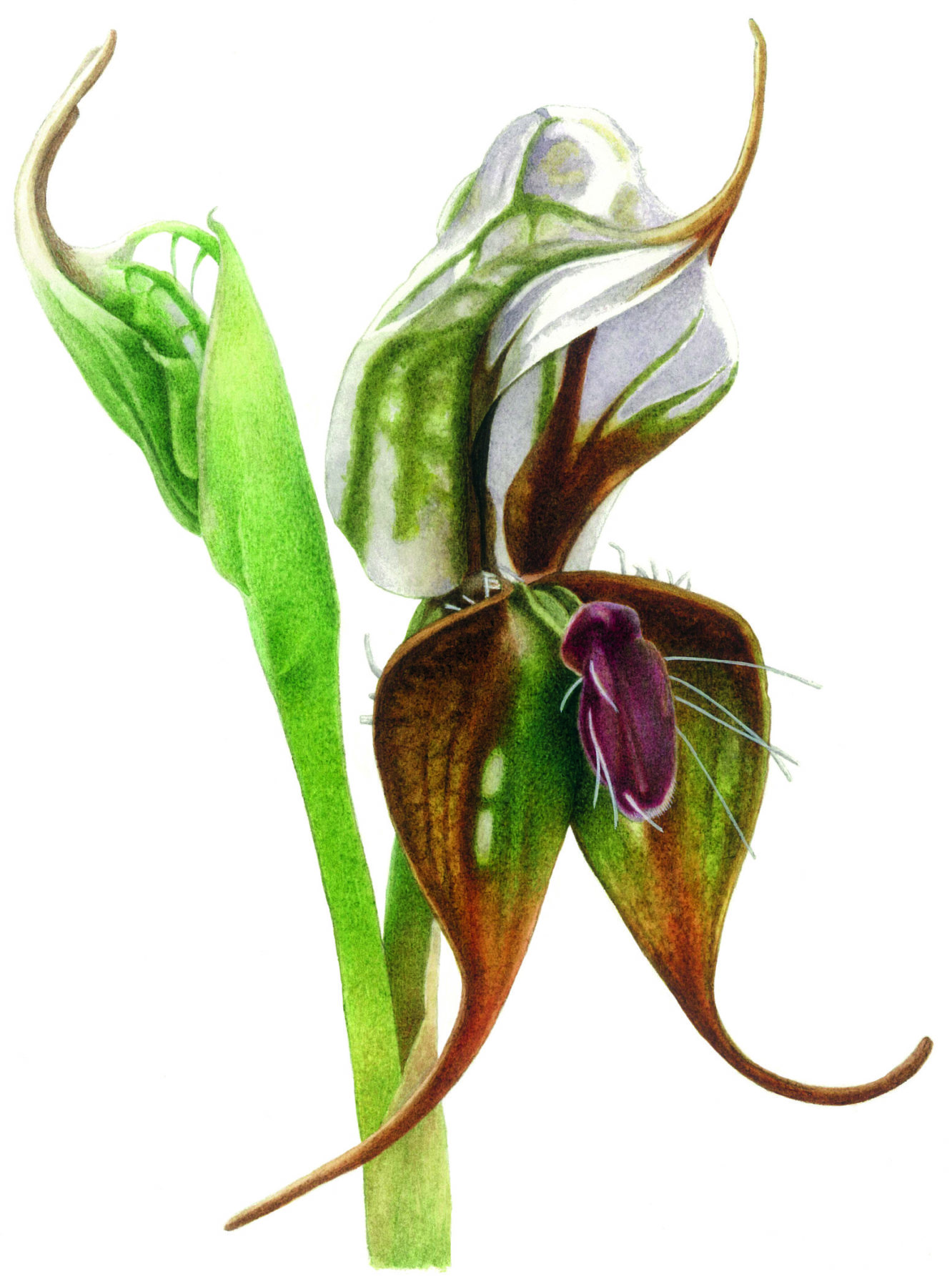
Known from only a few hundred plants on rock outcrops in the deserts of Victoria and SA, the desert greenhood is thought to be pollinated by fungus gnats (Mycetophillid flies) and germinated by Ceratobasidium fungi. These solitary plants have leaves at the base of their stems, which are completely withered by the time of flowering in spring.
Wimmera spider orchid
Caladenia lowanensis
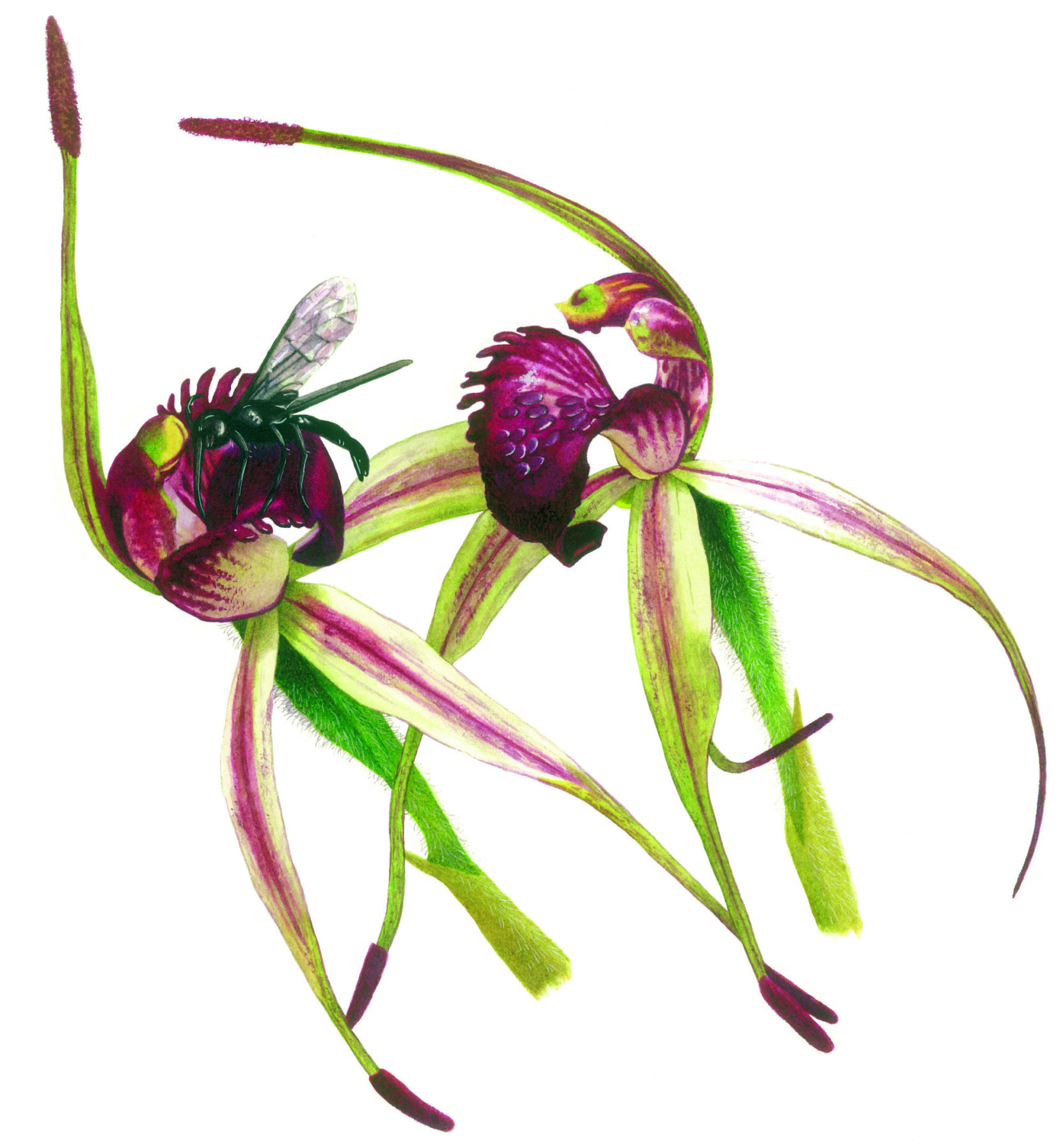
This striking, vulnerable orchid is known from a few thousand plants growing in open bulloke woodlands in Victoria’s northern Wimmera. Research has shown that the Wimmera orchid shares its thynnine wasp pollinator with at least eight other orchid species.
Purple beard orchid
Calochilus robertsonii
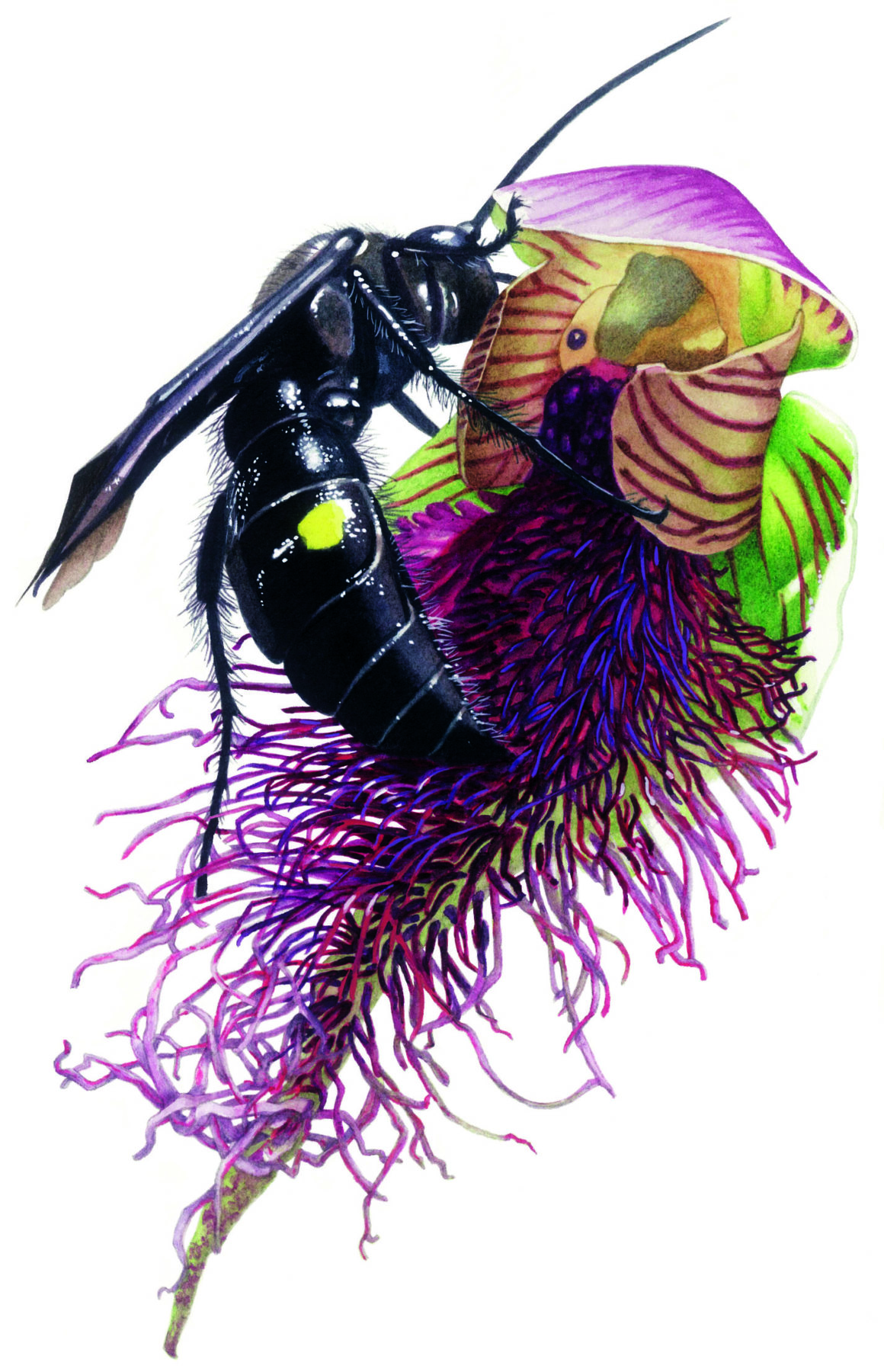
As the name suggests, the labellum (large, lip-like petal) of this species resembles the scraggly beard of a fairytale wizard. The species is widespread, and found throughout New Zealand and all Australian states, except the NT.
Crimson spider orchid
Caladenia clavescens

Only discovered in 2007, this endangered orchid is known from very few plants in Victoria’s central Goldfields. Conservation efforts led to the reintroduction of 60 propagated specimens into the wild in 2012. This orchid is thought to deceive wasps into pollinating it and is reliant upon Sebacina-like fungi to germinate.
Queen of Sheba
Thelymitra speciosa
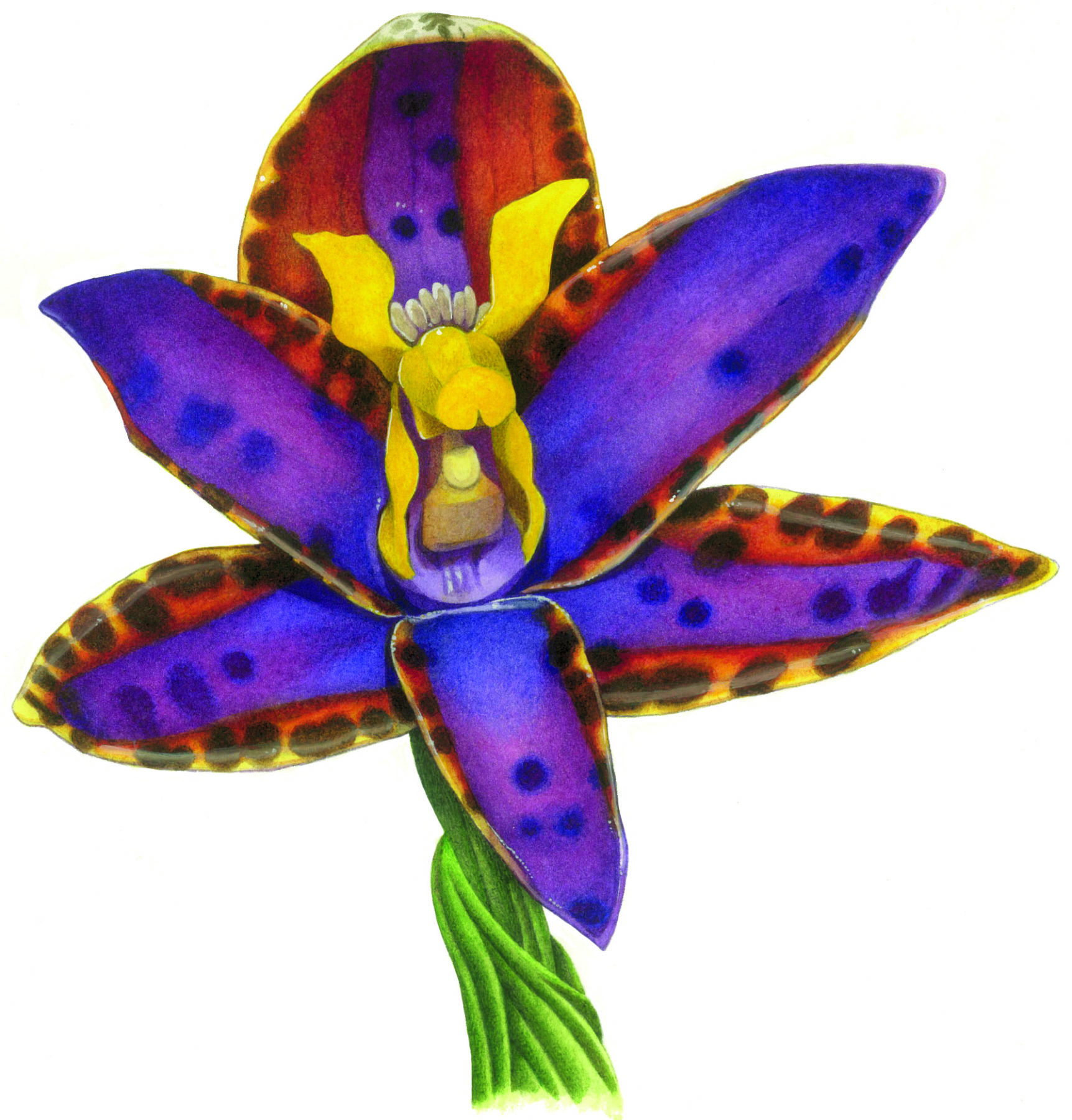
This flamboyant beauty is confined to WA and is not considered threatened. It grows in open, sandy clays in exposed plains within the Wheatbelt. It’s reliant upon Tulasnella fungi for germination. Orchids of this genus often mimic other nectar-providing plants in order to be pollinated, typically by bees.
Yellow-lip spider orchid
Caladenia xanthochila
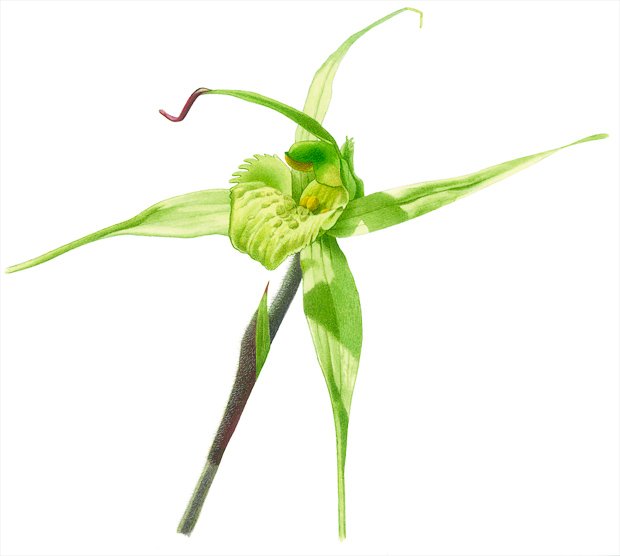
Just 1000 yellow-lip spider orchids remain in two sites in Victoria; the striking plant was once found in SA as well. Recovery efforts have uncovered that this plant is pollinated by a thynnine wasp. Two hundred plants, along with the fungal partner, have already been reintroduced into suitable habitat in Victoria.
Leafless tongue orchid
Cryptostylis hunteriana
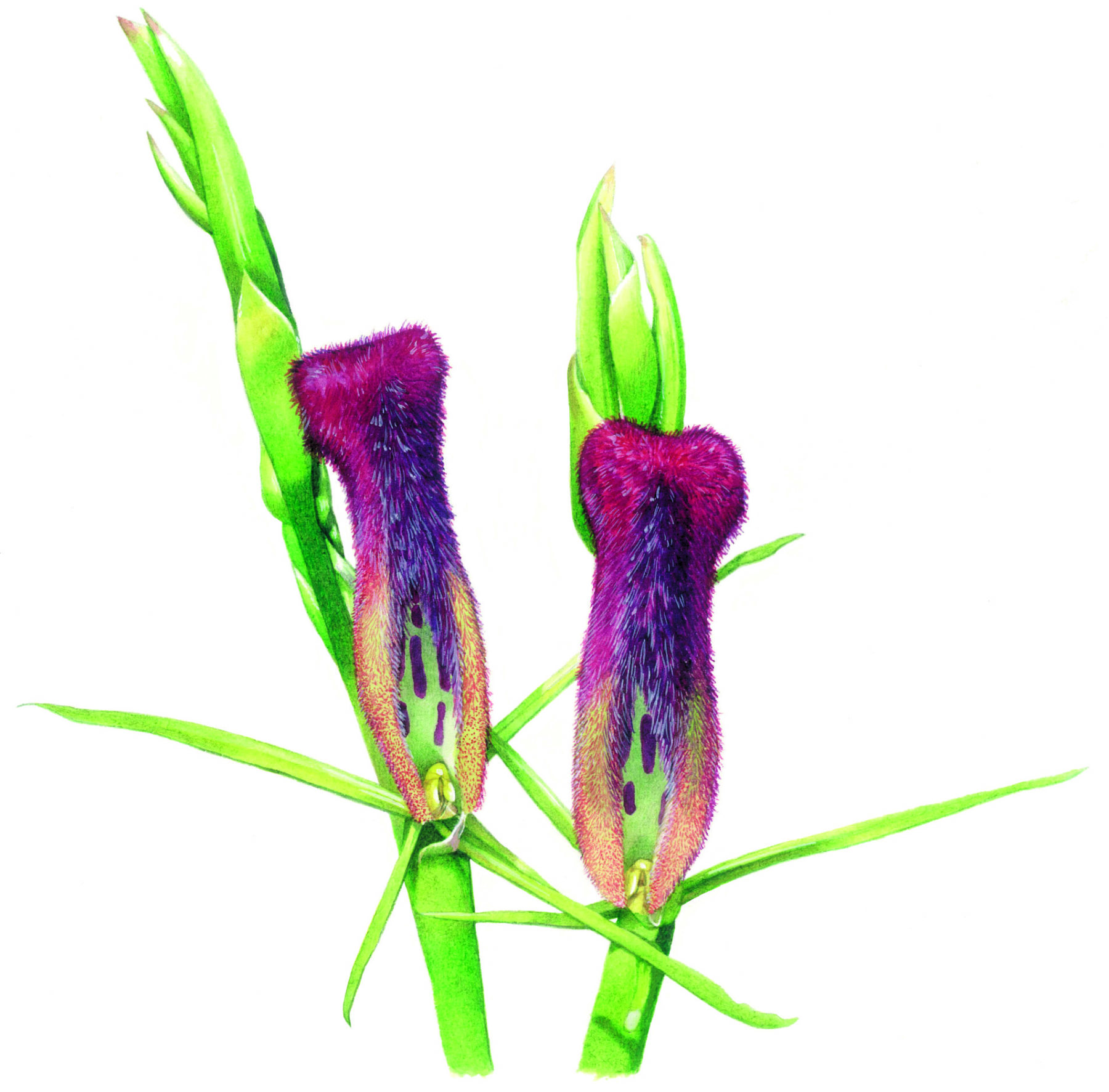
This species lacks leaves and draws all its nutrients from the decaying leaf matter around it through its fungal partner. This vulnerable orchid with velvet-like flowers is confined to parts of Victoria, NSW and QLD, and pollinated by an ichneumon wasp Lissopimpla excelsa.
Blunt greenhood
Pterostylis curta
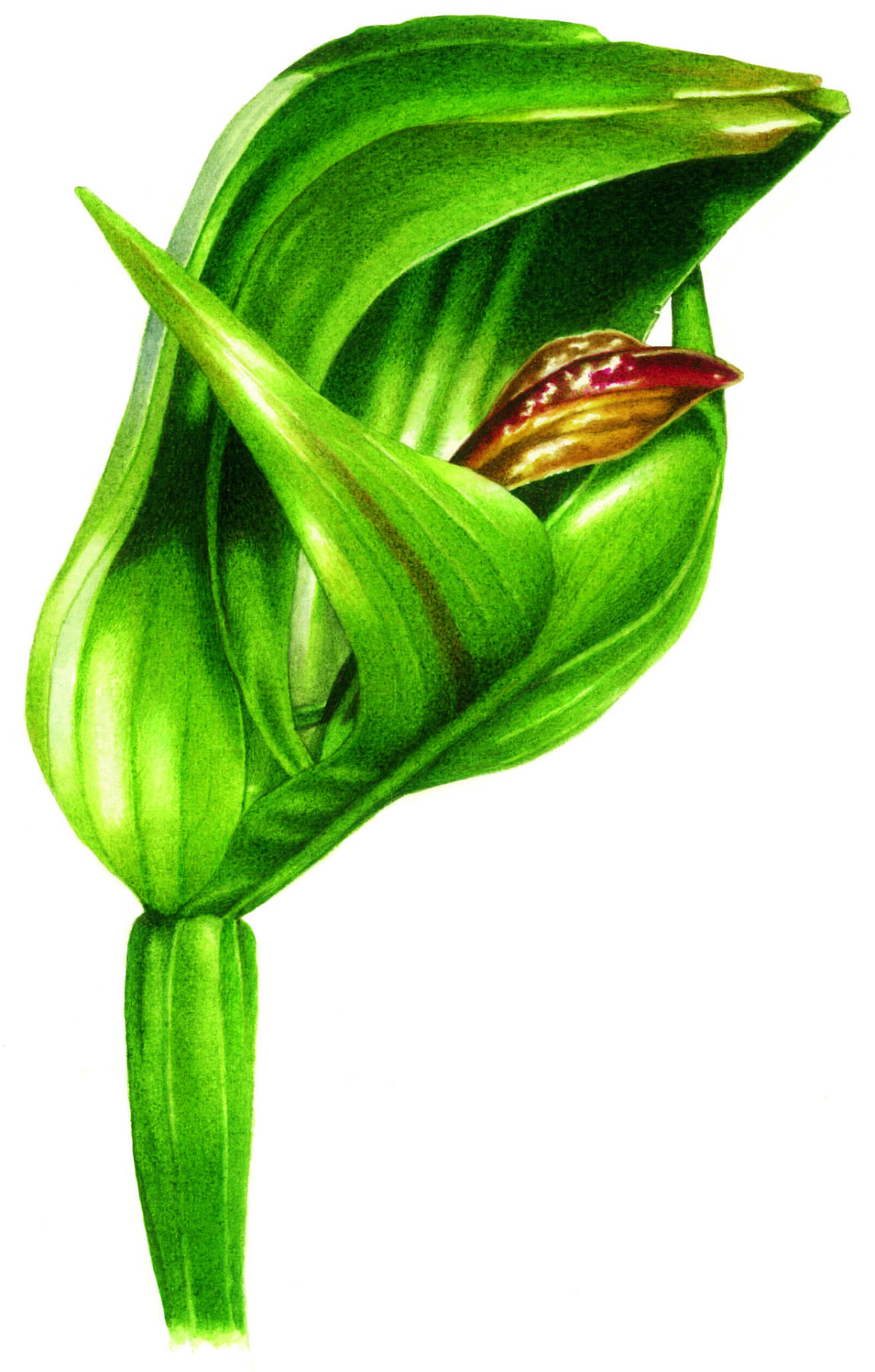
This diminutive greenhood is widespread in all states except WA and the NT. It flowers from winter through to summer and forms spectacular colonies of hundreds of plants. It is germinated by Ceratobasidium fungi and pollinated by Mycomya fungus gnats.
Large duck orchid
Caleana major
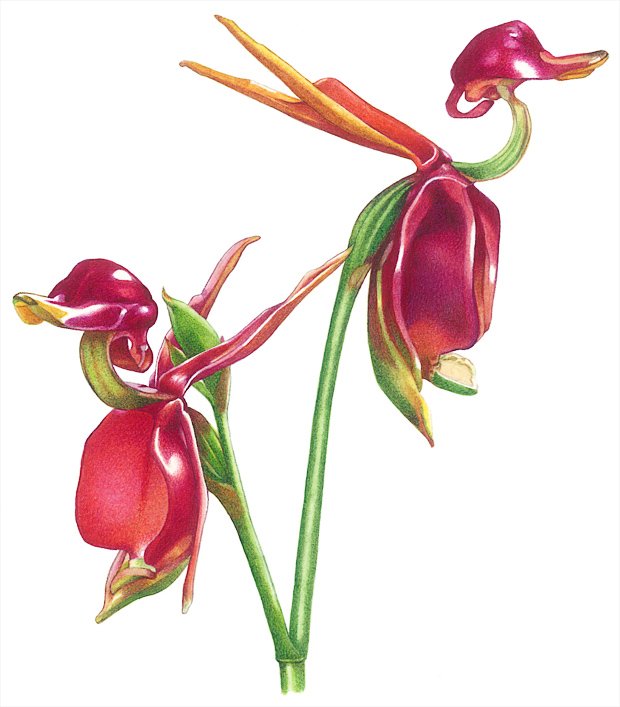
Resembling a caricature of a flying duck, this distinctive species produces up to five flowers between spring and summer. While not overly common, it is widespread in eastern Australia and Tasmania. It is reliant on a Tulasnella fungus to germinate and deceives wasps into pollinating it.
Sand-hill spider orchid
Caladenia arenaria
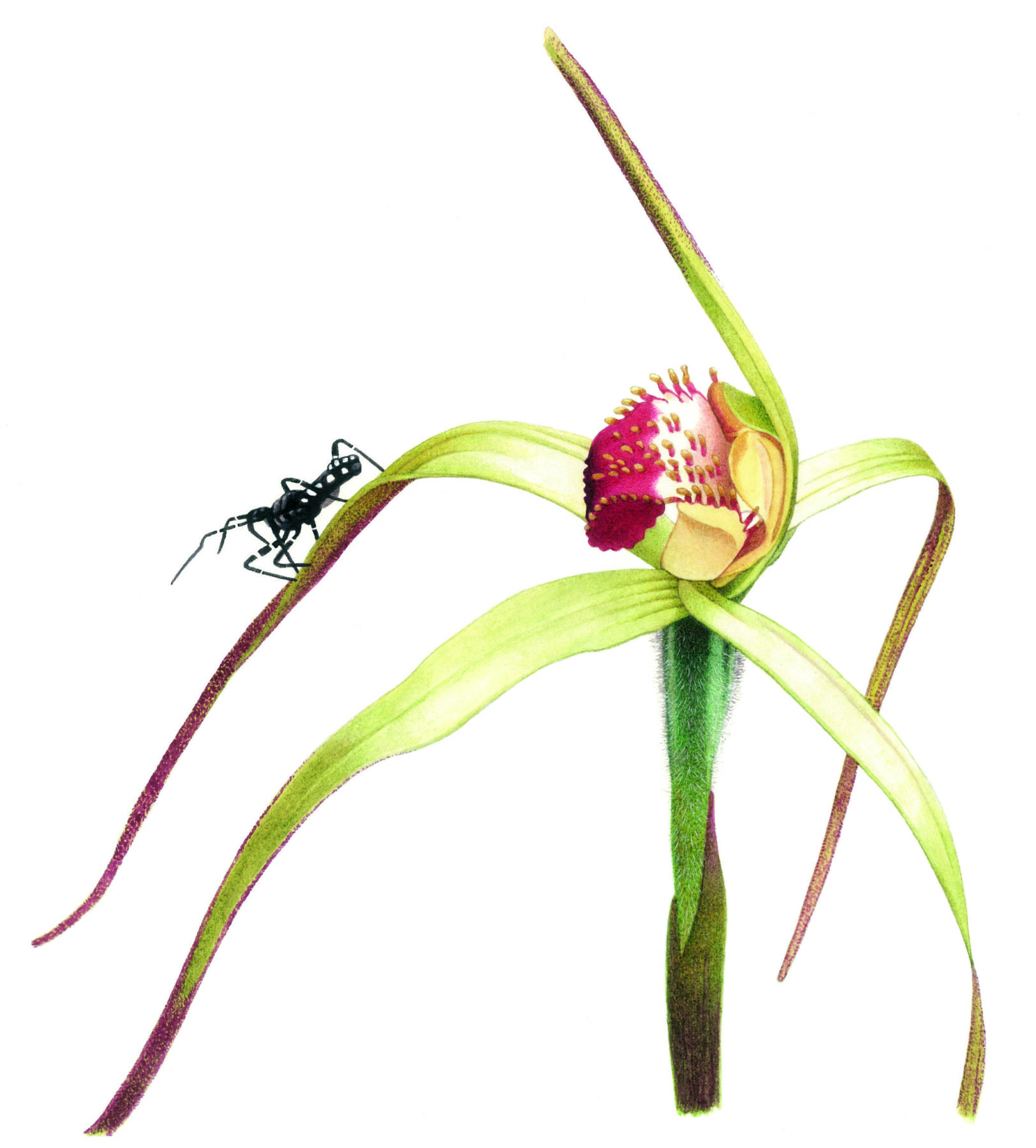
First described in 1882 from sand-hill habitats among native pines in NSW, this species is endangered, with only a few thousand plants remaining in the wild in NSW and Victoria. It deceives a thynnine wasp into pollinating it. Its seeds only germinate symbiotically in the presence of a fungal partner, Sebacina vermifera.
Wax-lip orchid
Glossodia major
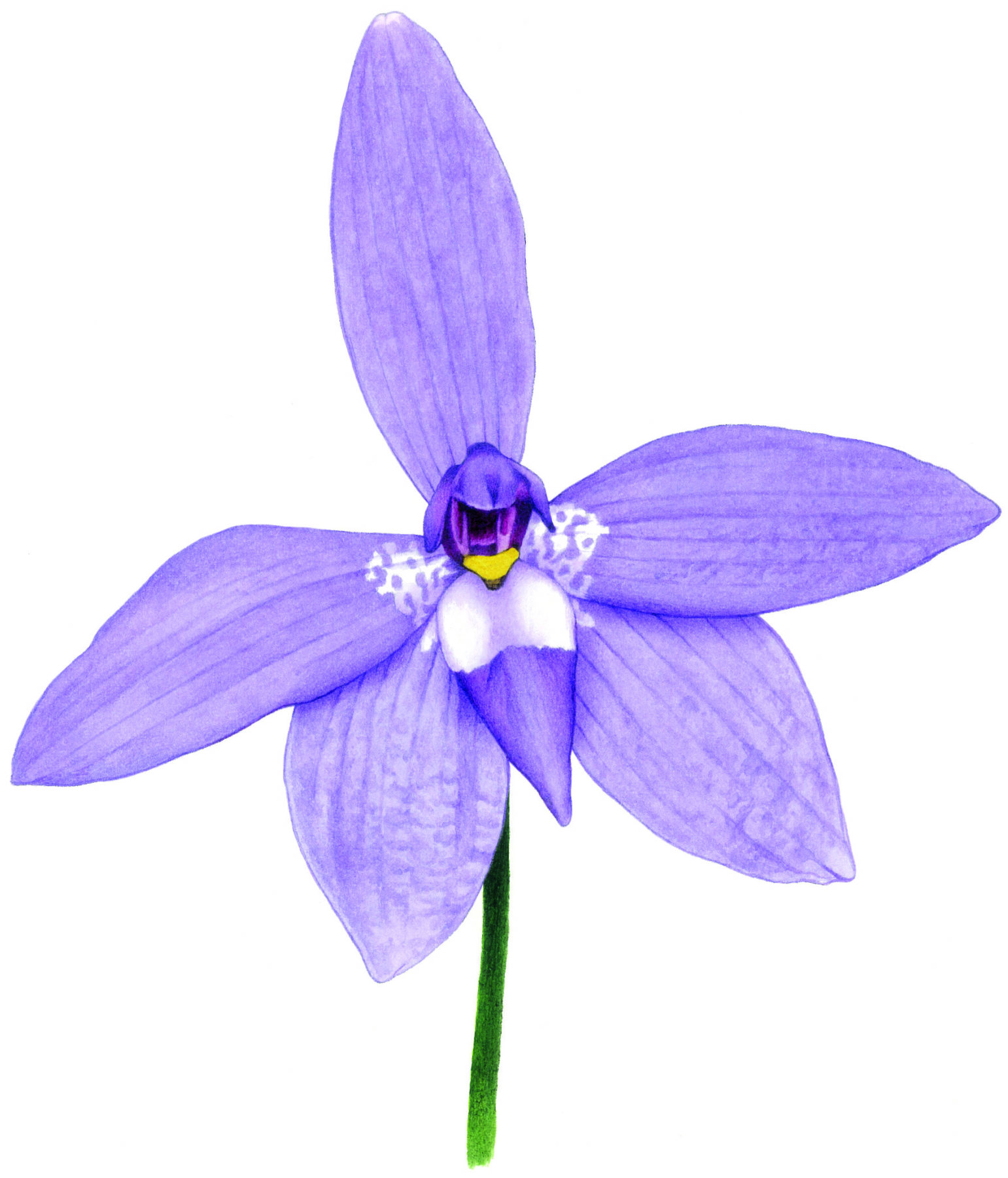
This bright-purple orchid is common and widespread, forming fields of colour in all states except WA and the NT. Notoriously difficult to propagate, it is germinated by Sebacina-like fungi and thought to be pollinated by bees.
Grampians duck orchid
Paracaleana disjuncta
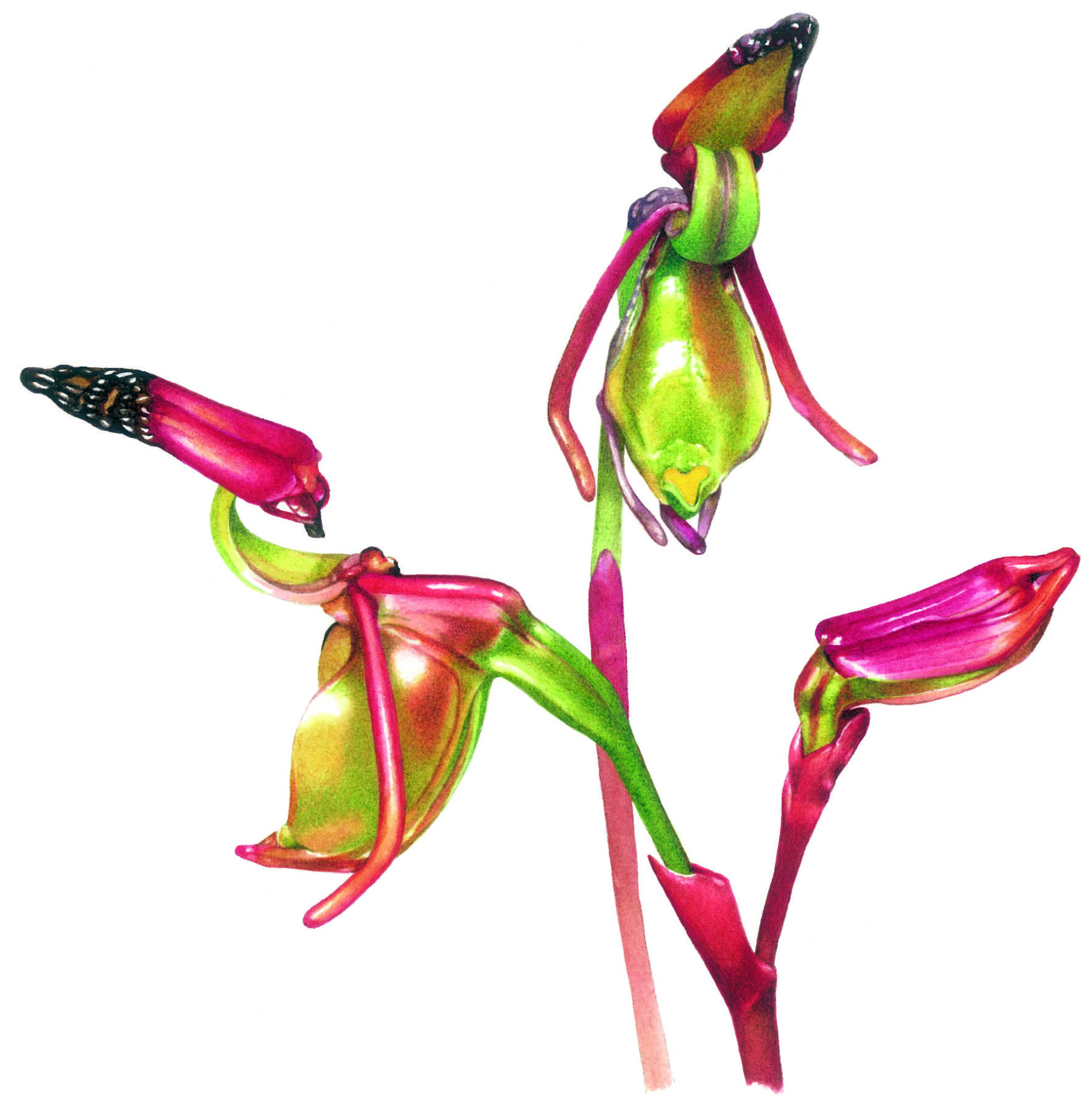
The small, oval leaves of this species emerge in May, withering by the time a single stem is produced. It bears a flower from November to January with a remarkable resemblance to a duck in flight. This orchid is pollinated by wasps that are tricked into thinking the flowers are females of their own species. It is threatened in Victoria but common in WA, and is reliant upon a baby-pink-coloured species of Tulasnella fungus to grow.
Metallic sun orchid
Thelymitra epipactoides
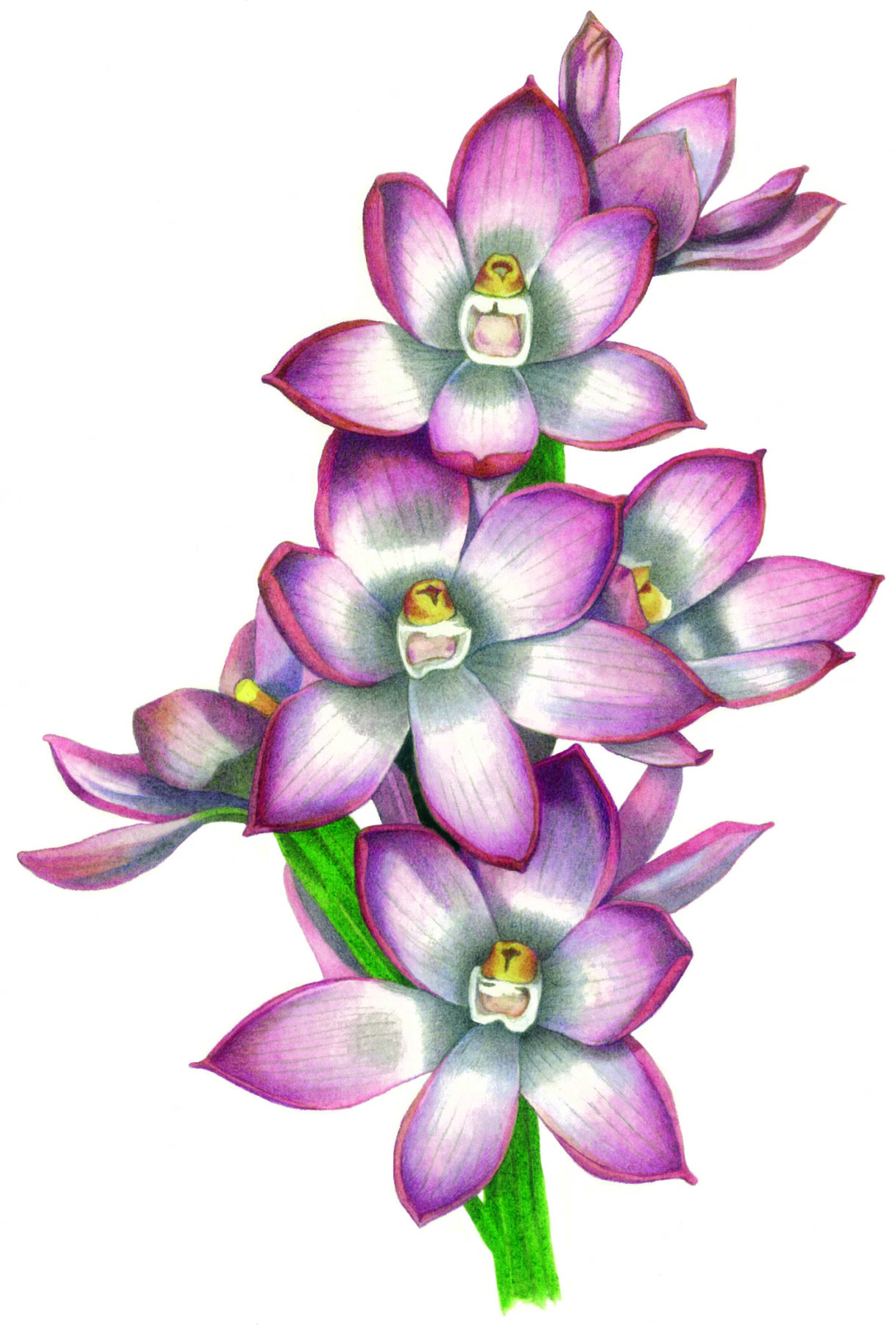
One of our most majestic orchids, this species was once widespread in southern Australia. It is now known from about 1000 plants in Victoria and SA. Conservation efforts in Victoria have led to the reintroduction of up to 3000 plants within its former range. This plant mimics nectar-producing plants to attract bee pollinators. Research suggests that Tulasnella-like fungi are required for germination.
Common bird orchid
Chiloglottis valida
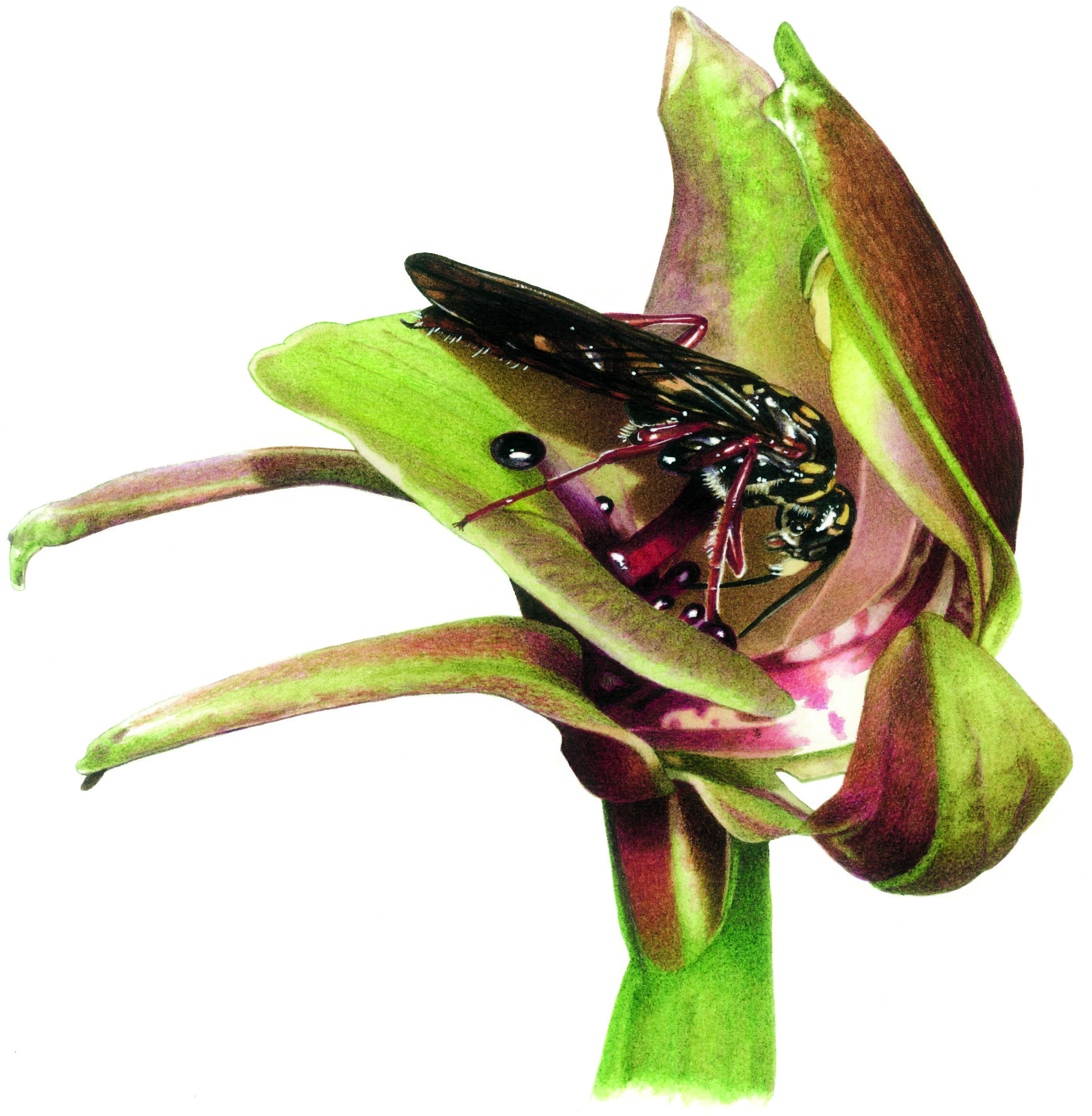
Widespread and diminutive, this species resembles a bird with its mouth open, and is found throughout Victoria, SA, TAS and NSW. It is pollinated by male wasps, which are attracted to the flowers from some distance away by pheromones. It’s thought that it has two geographically distinct thynnine wasp pollinators, attracted by two distinct odours in different parts of the range.
Emerald lip greenhood
Pterostylis smaragdyna
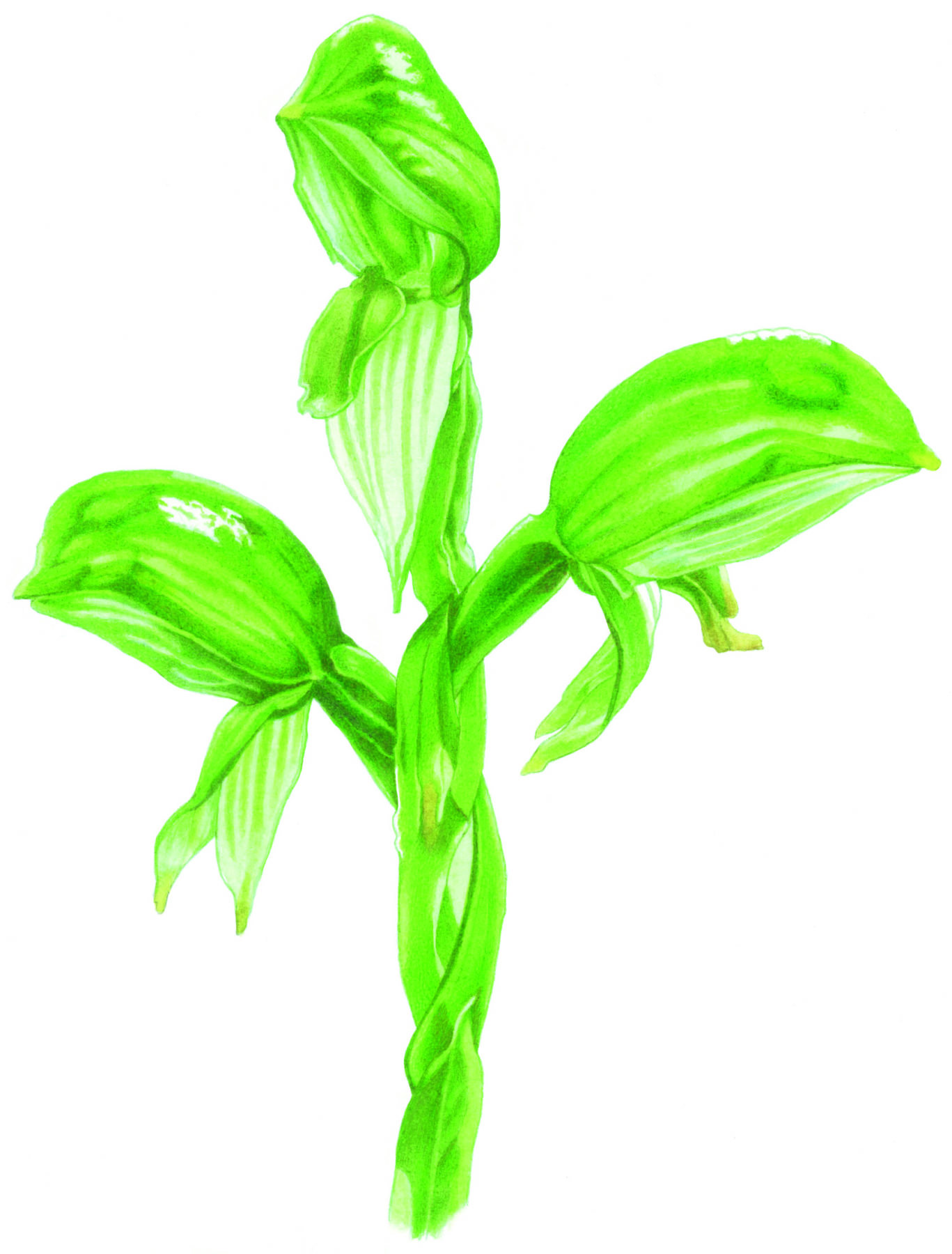
This winter-flowering orchid is germinated with fungi in the genus Ceratobasidium. It’s known from Victoria, SA and NSW. This species is thought to be pollinated by Mycetophilidae flies, but whether that’s for a nectar reward or due to some type of deceptive mimicry is unknown.
Audas’ spider orchid
Caladenia audasii
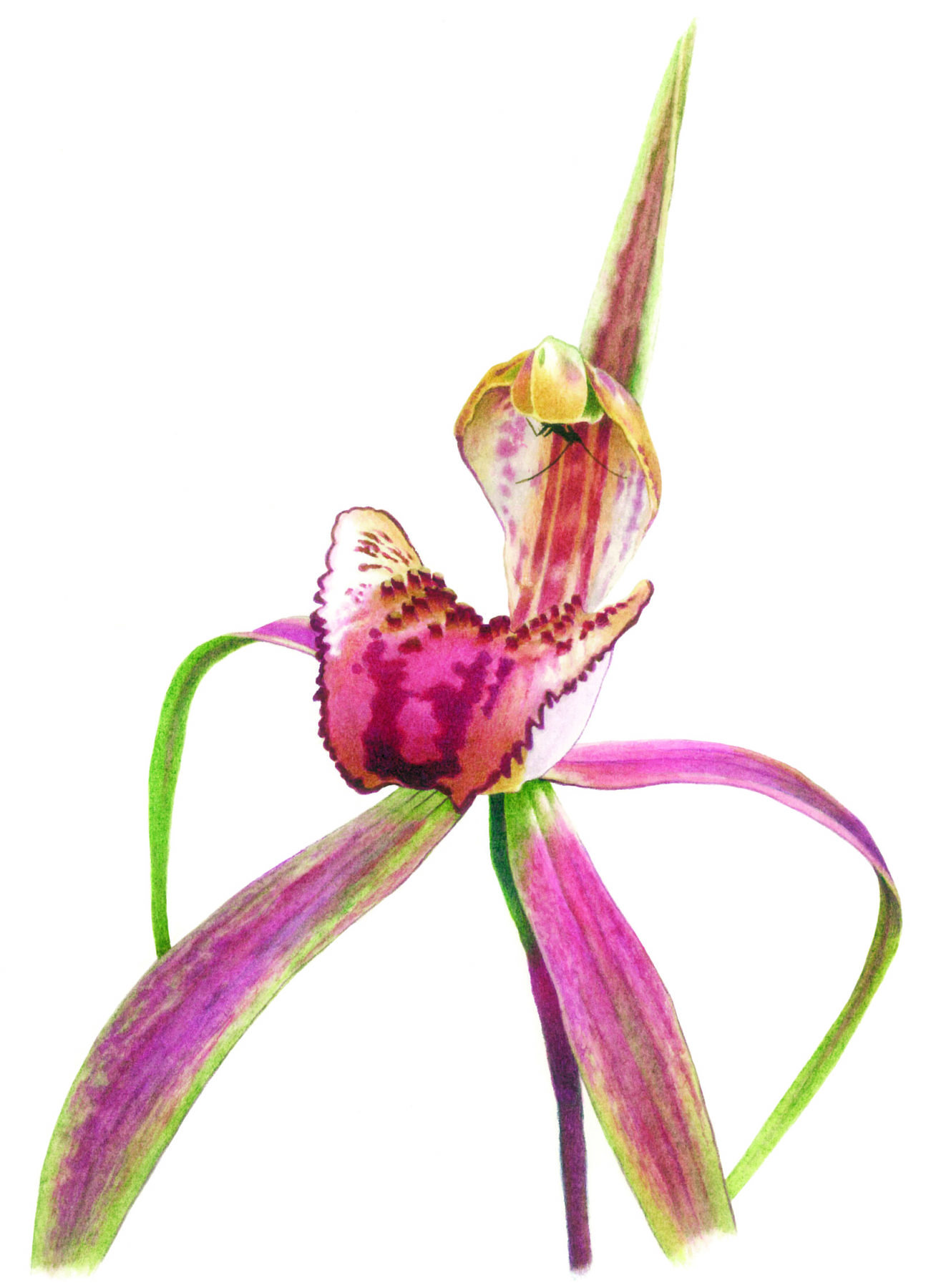
The Audas’ spider orchid is one of Australia’s most endangered plants, with just five remaining in the wild. It is currently listed as nationally endangered and is known to grow only in two box ironbark forest sites in Victoria. Research into how it is pollinated has only just begun.
Orford leek orchid
Prasophyllum viretrum
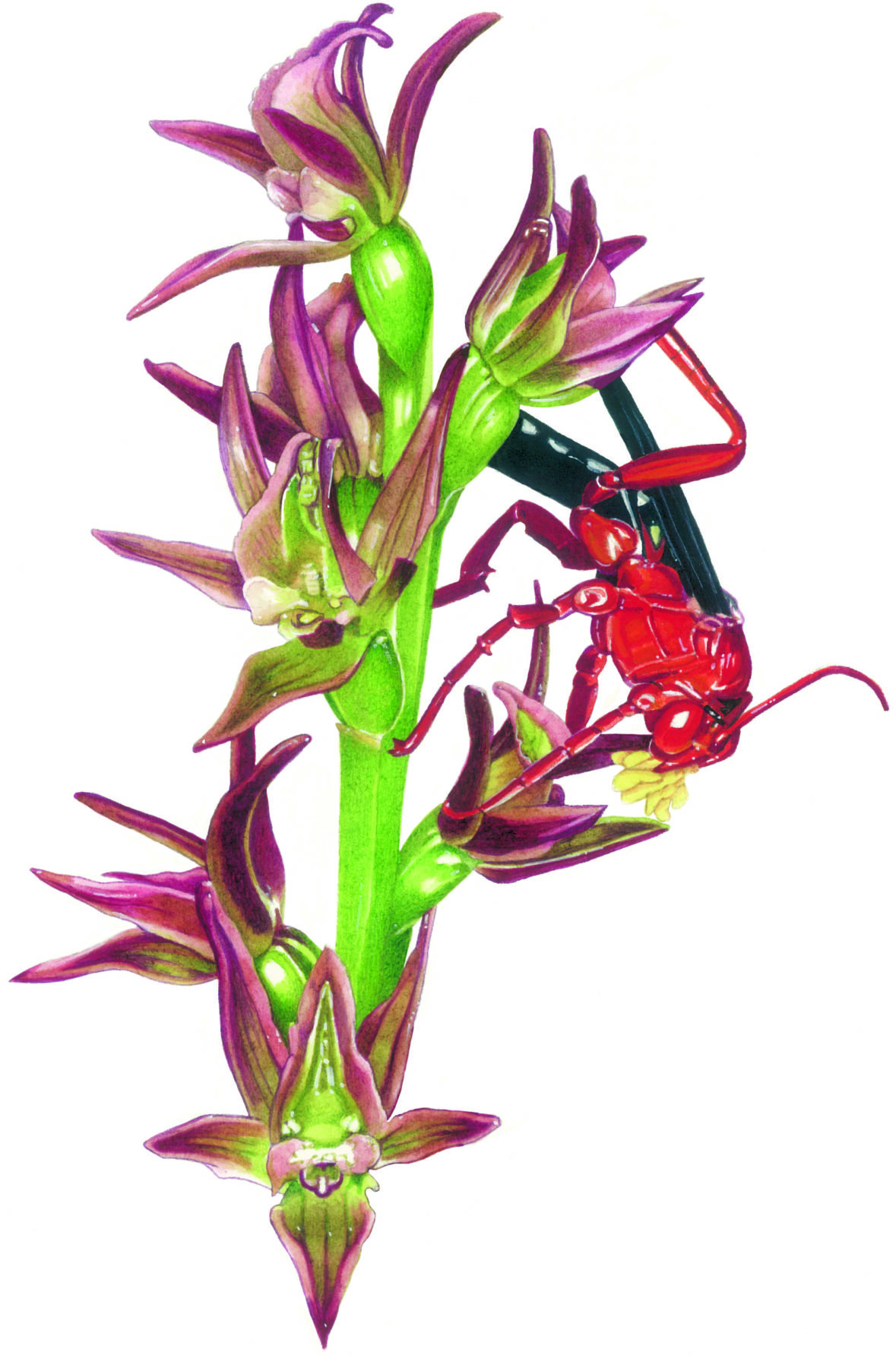
This endangered species is known only from a few small populations near Orford, Victoria, and on heavier alluvial clays on the Victorian volcanic plain. This species was only described in 2006. It’s thought to require Ceratobasidium fungi for germination, but its degree of dependence on the fungi throughout its life cycle isn’t known. This species provides a nectar incentive and attracts various pollinators.
Eastern mantis orchid
Caladenia tentaculata
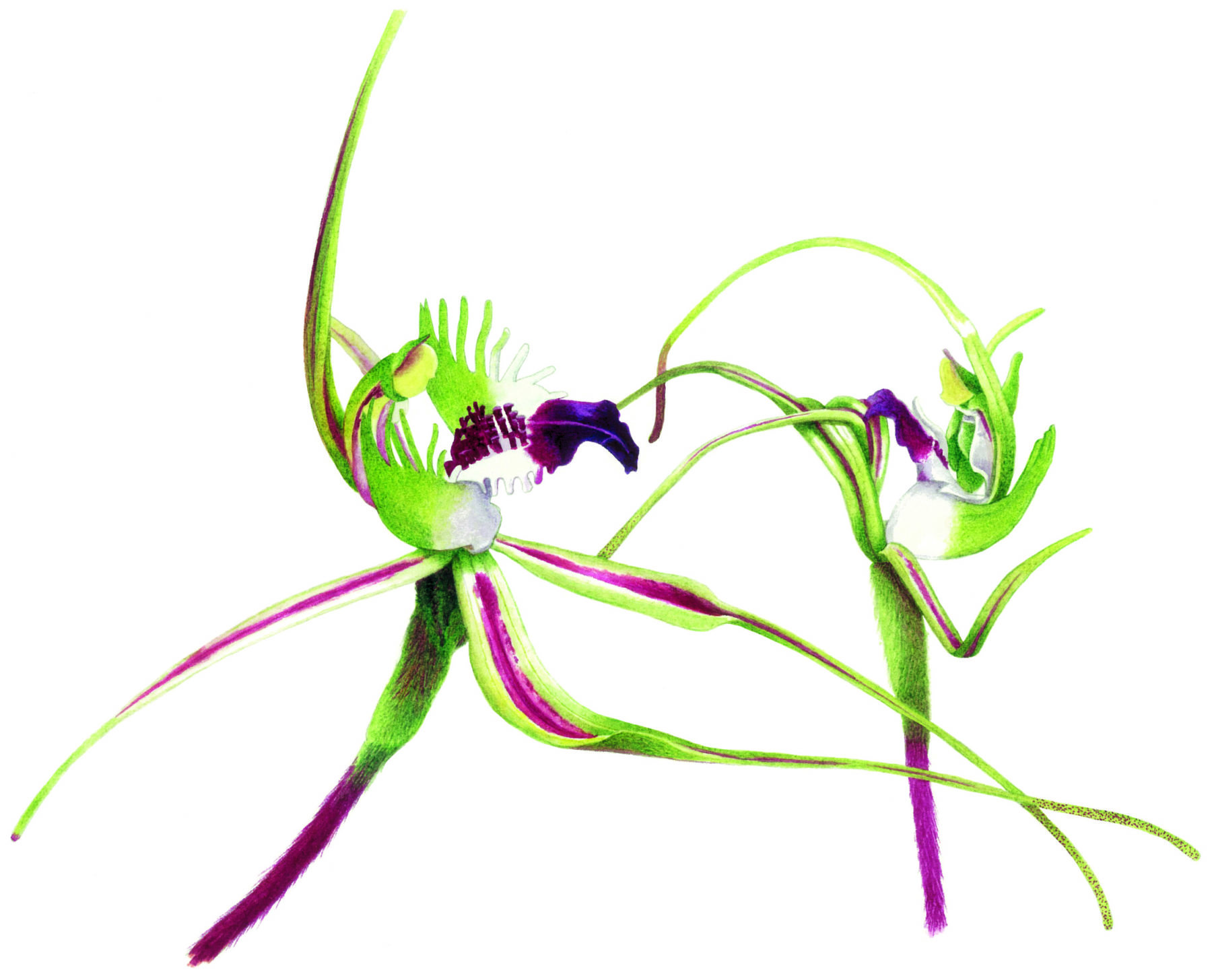
Found throughout Australia except the NT and Tasmania, this large spider orchid is pollinated by a thynnine wasp. It is unusual in that it occurs in a wide variety of habitats and varies in size throughout its range. It is thought that its ability to use several different types of Sebacina fungal partners, and the widespread distribution of its wasp pollinator, gives it a competitive advantage over endangered orchid relatives.
Veined helmet orchid
Corybas diemenicus
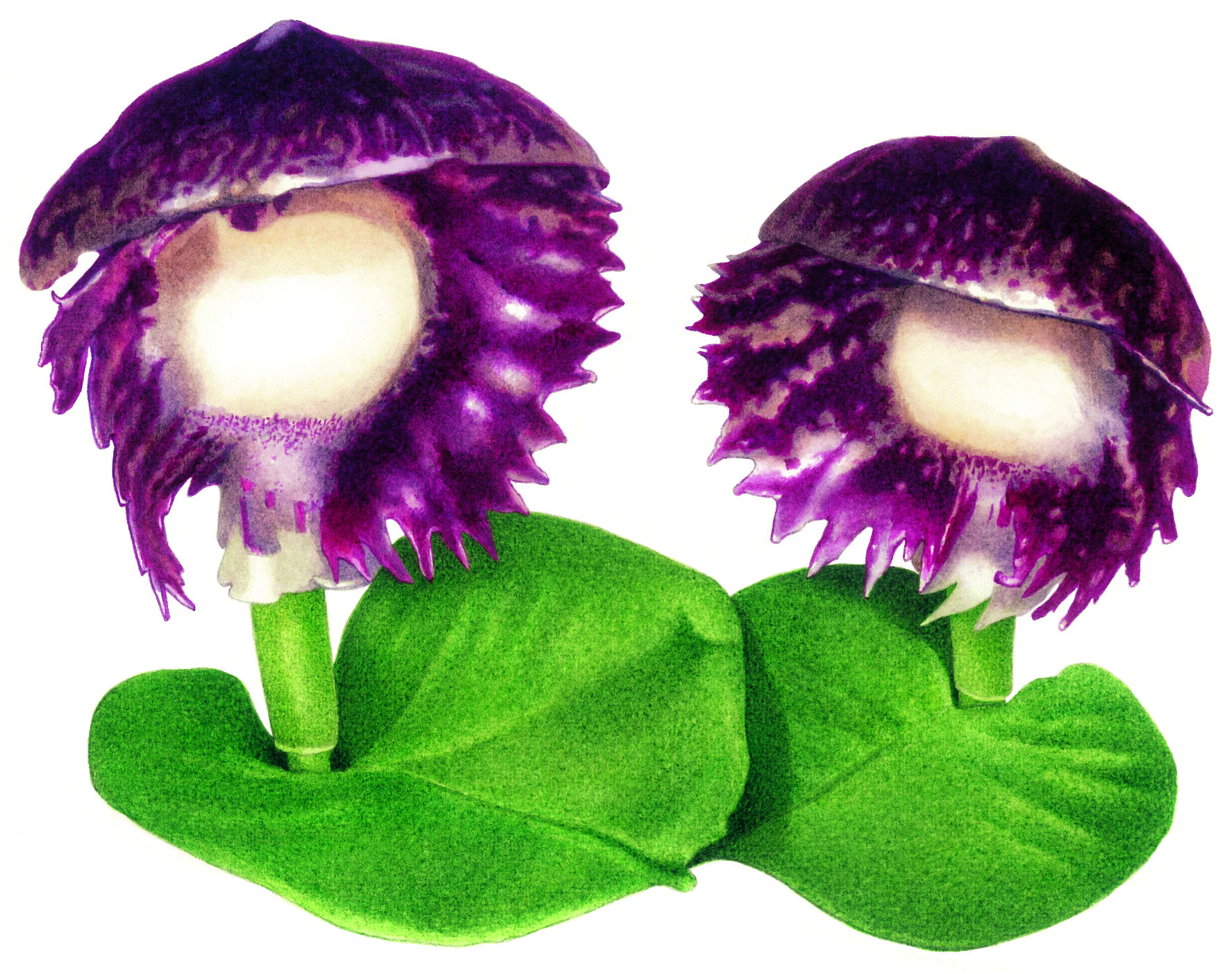
Resembling a snail, this tiny orchid has an intriguing pollination system. To hand-pollinate it, you need to remove the entire top part of the plant (the boss), in order to expose the reproductive parts (the pollinia and stigma). This winter-flowering species is common in moist habitats throughout Victoria and NSW.

